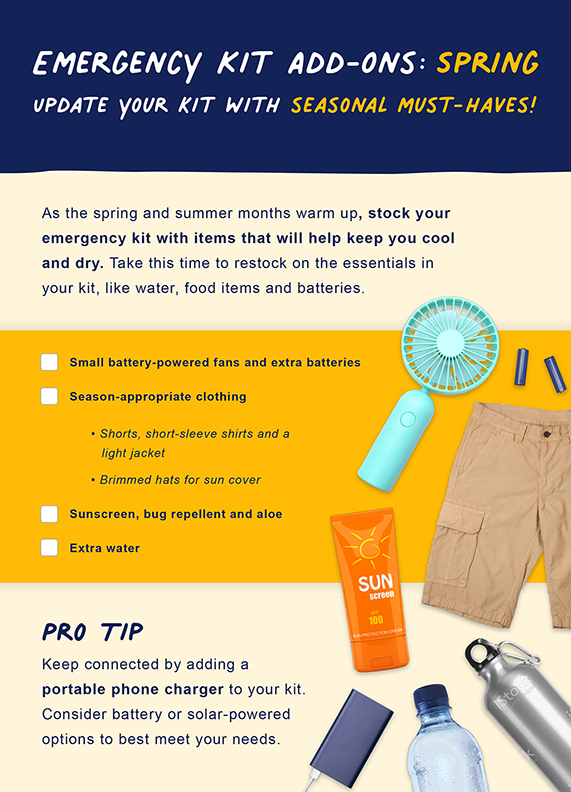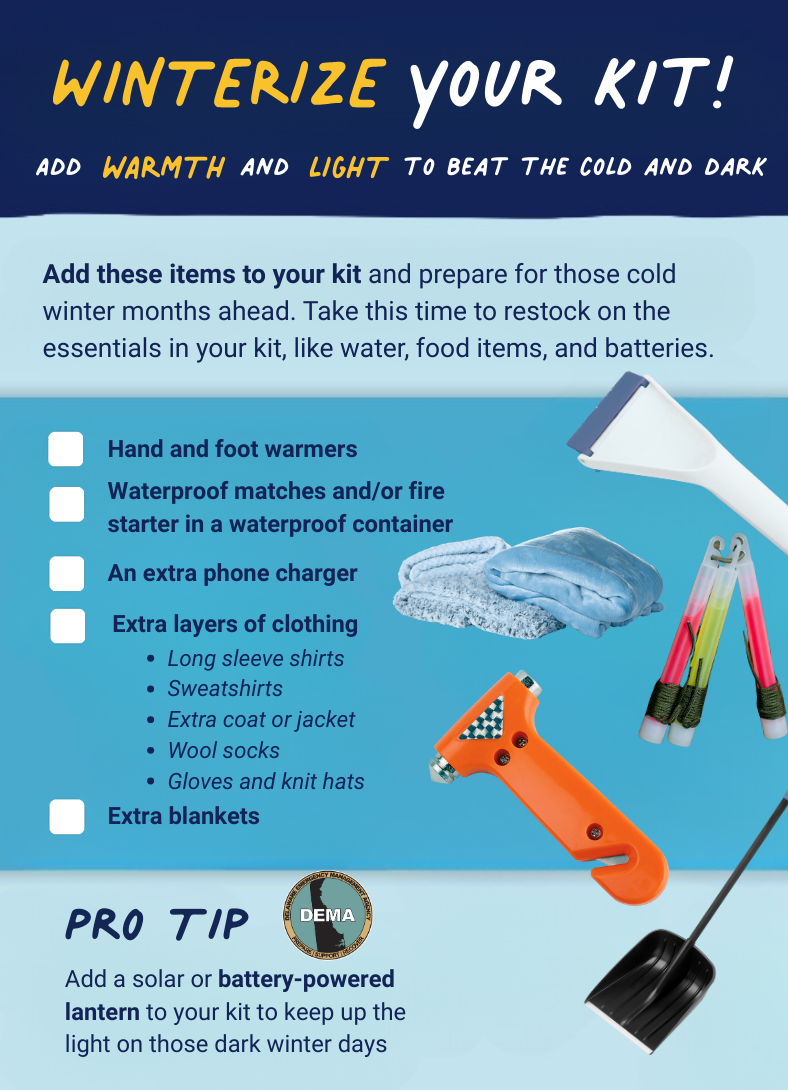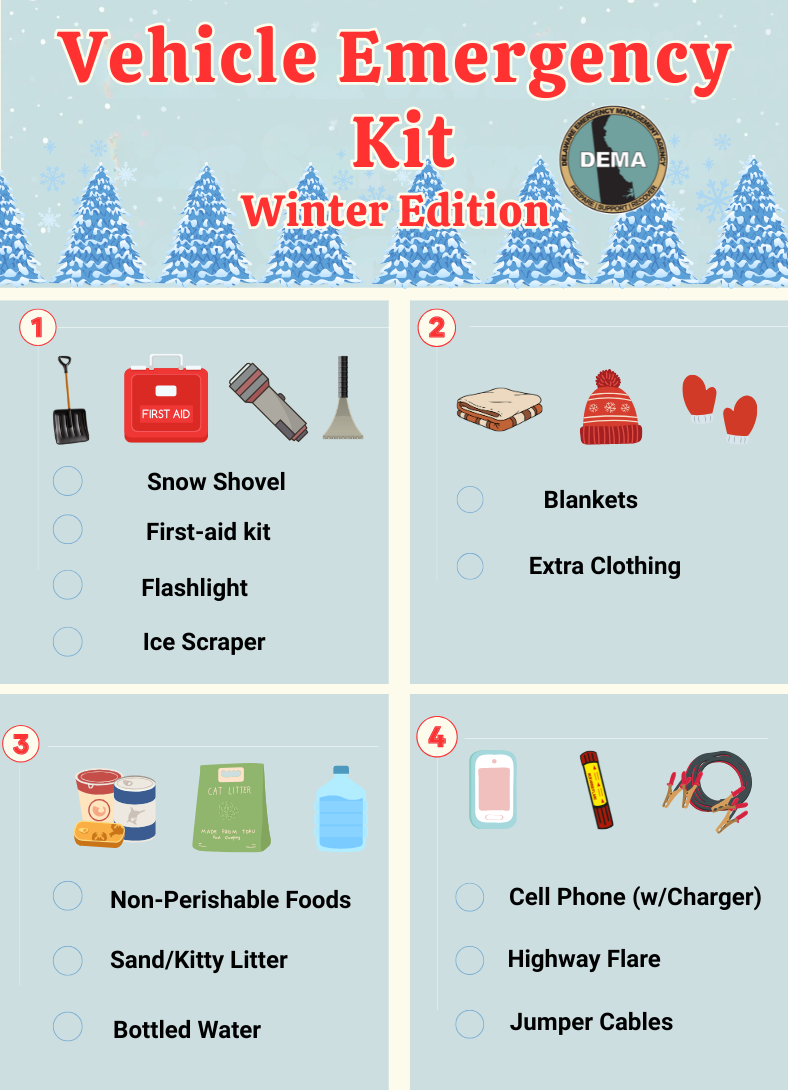
Build a Kit
Build an emergency supply kit with accessible and affordable items in the event of disaster, lost power, unsafe travel conditions or extended shelter-in-place orders. You need supplies ready to safely stay in place until the emergency passes.
Different types of kits:
- Emergency shelter-in-place kit: for an extended stay at home (three or more days).
- Go-bag: for immediate rapid evacuation of the home — a scaled-down version of the emergency shelter-in-place kit.
- Travel kit: for your vehicle or if you are traveling for work or vacation.
-
Basic Emergency
- Water – one gallon per person per day
- Food – non-perishable, three-day supply, and can opener if kit contains canned food
- First aid kit and medications (list of first aid kit items towards bottom of page)
- Personal hygiene items – toilet paper, feminine supplies, hand sanitizer, moist towelettes, and soap
- COVID-19 personal protective items – masks, disinfecting wipes, travel-sized soap for washing hands, hand sanitizer
- Flashlight
- Battery-powered or hand crank radio
- Extra batteries for radio, flashlight, etc. – periodically check the expiration dates of your batteries and replace as necessary
- Heavy work gloves
- Whistle to signal for help
- Cash – ATM and credit card machines may be out of service in event of power outages
- Mess kits, paper cups, plates, paper towels, and plastic utensils
- Cell phone power bank or car charger
- Copy of important documents in waterproof portable container or sealed Ziploc bags
- Recent photos of your children in waterproof portable container or sealed Ziploc bags
- Special-needs items for children – medications, toys, infant formula, and diapers
- Special-needs items for seniors or people with disabilities – medications, glasses, hearing aids and batteries, dentures and cleaner, and personal care items
- Complete change of clothing for each person – weather and season appropriate, such as a long-sleeved shirt, long pants, underwear, socks, sturdy shoes, and rain gear
- Blankets or sleeping bags
- Pen, pencil, and paper in waterproof bag
- Plastic sheeting and duct tape
- Garbage bags and plastic ties
- Fire extinguisher
- Matches in a waterproof container
-
Vehicle Emergency
- Water – one gallon per person per day, including water and a container for your pets
- Cell phone car charger
- First-aid kit and medications (list of first aid kit items towards bottom of page)
- COVID-19 personal protective items – masks, disinfecting wipes, travel-sized soap for washing hands, hand sanitizer
- Snacks that will not be affected by the heat in the car
- Emergency contact list in waterproof container or sealed sandwich bag
- Personal hygiene items – toilet paper, feminine supplies, hand sanitizer, moist towelettes, and soap
- Whistle to signal for help
- Cash – ATM and credit card machines may be out of service in event of power outages
- Blanket, towel
- Flashlight with extra fresh batteries
- Rags, paper towels or pre-moistened wipes
- Basic set of tools, duct tape, shovel, and car emergency warning devices (flares or reflectors)
- Jumper cables
- Tarp
- Raincoat or poncho
- Gloves
- Special-needs items for children – medications, toys, infant formula, and diapers
- Special-needs items for seniors or people with disabilities – medications, glasses, hearing aids and batteries, dentures and cleaner, and personal care items
- Pen, pencil, and paper in waterproof bag
- Mess kits, paper cups, plates, paper towels, and plastic utensils
- Matches in a waterproof container
-
First Aid
- Cleansing agent/soap and antibiotic towelettes
- Disposable gloves (consider nitrile to avoid possible latex allergy problems)
- Masks (at least 2 per person just in case one is lost)
- Adhesive bandages in a variety of sizes
- Sterile dressings and gauze
- Ointments – antibiotic, burn, anti-itch
- Eye wash solution
- Scissors
- Over-the-counter medicines – pain relievers, allergy relievers, anti-diarrheal medication, laxatives
- Prescription medications – insulin, heart medicine, asthma inhaler or other breathing treatment
- Prescribed medical supplies – glucose monitoring equipment, blood pressure monitors
- Tourniquet (to learn about how to Stop the Bleed, including how to use a tourniquet, visit StopTheBleed.org (link opens in new tab))
-
Pets
The Delaware Office of Animal Welfare (link opens in new tab) and the Humane Society of the United States (link opens in new tab) suggest the following items to include in an emergency kit for your pets:
- Additional water and food – recommended 1 gallon per pet per day
- Collar with ID tag, leash or harness, and record of microchip
- Medications and first-aid kit
- Important documents in a plastic zip-top bag, including: medical and vaccination records; license and microchip numbers; and any special instructions for your pet
- Current photos of you with your pet in waterproof portable container or sealed Ziploc bags
- Transport crate or carrier
- Bedding and toys
- Sanitation supplies, such as waste bags, litter and box, paper towels, and cleaner
- Garbage bags and plastic ties
- Blankets or sleeping bags and pet bedding
- Special-needs items
- Vet records (including license, vaccination, and microchip)
- Pet containment (crate or carrier) and restraint (collar with ID tag, leash, and harness)
Additional Tips
- Replace expired items as needed. Consider reviewing items at least twice a year, like during the time change.
- Re-think your needs every year and update your kit as your household needs change.
- Consider adding items as the seasons change, like adding a blanket, gloves and a scarf to your vehicle kit.



